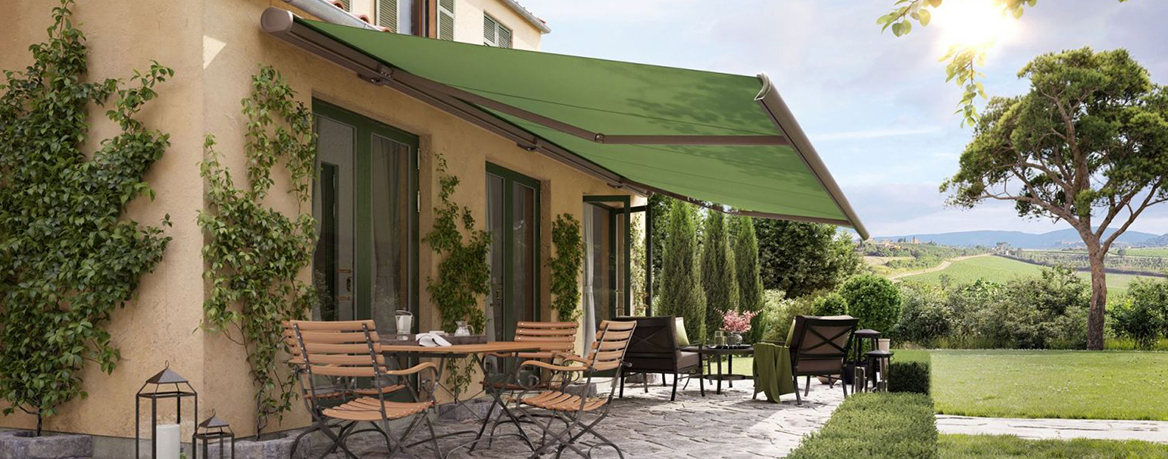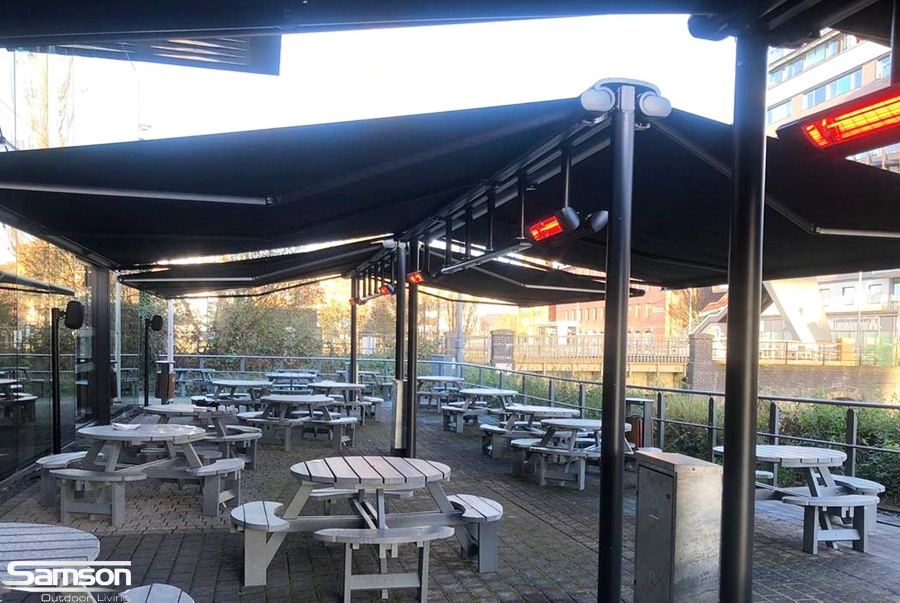Inspiration
We Have A Number Of Sources Of Solutions Thant Should Prove Inspirational For You.
Award Winning Awnings | High Quality | Technologically advanced
Markilux are the gold standard for retractable fabric awnings, pergolas and blind solutions. They design, test, develop and manufacture every aspect of the awnings they produce. From the gear mechanisms to the high quality textile covers, Markilux make it themselves, to an excellent, no compromise, high standard. This commitment to quality across the board has earned them multiple awards over the years, including the Interior Innovation Award, and iF Design Awards. Simply put, Markilux awnings are renowned for a reason. German engineering and innovation design has resulted in guaranteed worldwide demand from anyone demanding high quality and wants the best for their home or business.
5 years warranty as standard on all electric drivers.
Design Awards
Award winning, world class awnings, manufactured to order to the highest standards to create premium shading and outdoor weather protection solutions. Guaranteed longevity through engineered and highly developed products.
The Markilux range consists of a huge span of various models that are inclusive of all requirements, from simple sun shading to more advanced solutions and accessories, including built in LED lighting options, drop down shading valances, external vertical blinds, sliding fabric doors and coupling units for very large areas. They represent the very best in design, quality and performance and if you have any interest in high quality and longevity through engineered design then look no further.
With hundreds of the very highest quality German manufactured and unique fabric colours and designs, cassettes of different shapes and customisable colours, and bespoke measurements for each application, the Markilux awning range offers a retractable shading solution for every garden, patio or commercial environment.

One of the Markilux original awnings with compact, rounded, slim design, but still offering sizes up to 5000mm x 3000mm in made to measure sizes. Manual or electric operation and end fix brackets for face, top or roof fixing.
Prices from £3,100

Beautiful design folding arm awning with 10 colour combinations for the unique cassette. Electric operation as standard with LED line lighting option. Sizes up to 6000mm wide and 3500mm projection
Prices from £4,500

A classic Markilux awning, built for durability and flexibility. Multiple configuration options, with coupling available up to 13900mm wide. Sizes up to 7000mm wide and 4000mm projection.
Prices from £4,500

A favorite for its strength, thanks to the carry bar fixture. A semi-cassette awning with full fabric protection when closed. Ideal for larger sizes and the Syncra system. Manual or electric operation with various options to enhance.
Price from £3,200

The folding arm awning with a greater projection than the width by crossing over the arms when closed. Perfect for building corners or in between walls when maximising shading. All the features of the 1600 awning with manual or electric operation.
Price from £3,600

An open cassette awning of notable quality and design. Manual or electric operation with LED lighting options and multiple fixing position options. Stretch option for projection greater than width. Sizes up to 7000mm wide and 4000mm projection
Price from £2,800
For more advanced and usually larger outdoor weather protection solutions, look no further than the Markilux retractable pergola canopy structures and fabric roof systems. These systems are used extensively for both domestic and commercial applications with high levels of performance as standard. Bespoke sizes and specifications to suit.
With the Pergola models offering shelter from both the sun and rain, the Syncra ‘butterfly awning’ providing cover for large commercial applications, and the Markant, a luxurious free-standing or wall mounted system, various bespoke options can be tailored to every application.

Made to measure, electric, retractable fabric pergola system with modern clean lines and tracfix, zipped fabric for maximum cover tension when in use. Sizes up to 6000mm wide and 6000 projection as one unit, coupled units for larger sizes. LED light options and adjustable height.

The original retractable electric pergola system from Markilux offering the highest performance in sun, wind and rain for domestic and commercial outdoor areas. Sizes up to 6000mm width and 6000mm projection, but can couple multiple times for very large areas. LED lighting options, vertical front drop down shading and adjustable post heights.

Commercial or domestic weather protection all year round with this retractable pergola system. Folding fabric roof with built in aluminium support struts and traffic zipped side channels for ultimate rainwater protection. Sizes up to 7000mm wide and 7000mm projection but also up to 25 metres wide with 5 roof fields. LED lighting and multiple optional front and side infills.

The classic outdoor sun shade and rain protection system for commercial applications and very large areas. The super strong engineered framework system from Markilux creates the basis for made to measure butterfly awning solutions. Retractable folding arm awning options to one or both sides of the aluminium framework. Sizes to suit by connecting systems side by side.

The ultimate retractable fabric roof pergola system as free standing or wall mounted. Rainwater is channelled out of this roof system and away. As a sun shading system you always have high levels of natural light depending on fabric choice. Infill one or all sides to create wind, privacy and rain protection. Single unit sizes up to 6000mm x 6000mm and can be coupled multiple times for very large spaces.
Need help deciding on the right awning for your needs or require more information?
Made to measure electric operated sun shading systems for conservatory roof and glass verandas and rooms. Adaptable to open spaces within other structures to provide adjustable sun shading and rain protection when installed at a minimum pitch.

Retractable sun protection for larger glass roof and conservatories. Electric operated as standard with tracfix channel guides for maximum fabric tension and further tension with gas pistons. Sizes up to 7000mm wide and 7000mm projection.

Retractable sun shading for conservatories where the guides need to be inset for mounting such as a hipped style roof. Electric operation as standard with tracfix channels and gas piston tensioning. Sizes up to 600mm wide and 500mm projection.

Retractable external mounted sun shading awning for smaller roof sizes. Electric operated with tracfix channels for maximum fabric tension. 770 – square cassette and 870 rounded.
Sizes up to 4500mm wide and 4000mm projection.

Control the light and heat with this underglass mounted manual or electric blind system with minimalist design and high performance from tracfix zipped side guides and optional LED lighting. Sizes up to 6000mm wide ad 6000mm projection

For the largest sizes this electric operated underglass blind offers high performance with tracfix guides and great options such as LED lighting in the side guides and drop down front valance for vertical shading. Sizes up to 6000mm wide and 6000mm projection. Electric operation as standard.
High quality engineering and the highest quality fabrics from Markilux create these exquisite external, electric operated, sun shade and wind protection blinds, for control of your home climate and also providing sunlight, wind and privacy control all year round.
Unique fabrics allow partial vision and some models have a tilting arm function to provide additional sun shading but maintain clear vision out. Sizes up to 6m wide and 6m high.

Vertical external blind with electric operation and tracfix zipped side channels. Sizes up to 4500mm wide and 3000mm high. Gravity fed blind.

Classic, full cassette, drop arm awning for window shading whilst maintaining vision outwards. Manual or electric operation with gas piston tensioning for the fabric cover. Sizes up to 7000mm wide and 2500mm projection.

Unique external window shading system combining partial vertical blind and extended drop arm awning functionality in manual or electric operation. Gas piston tensioning for fabric cover providing high wind resistance. Sizes up to 3000mm wide and 3000mm high.

Outdoor living – the trend of enjoying life outdoors and spending more time outdoors. People are recognizing the benefits of enjoying nature, fresh air, and the overall experience of being outside. Whether it’s having a coffee on a café terrace, socializing with friends in a beer garden, or playing in a playground, these outdoor activities contribute to an enhanced quality of life.